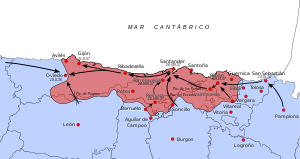War in the North
| War in the North | |||||||
|---|---|---|---|---|---|---|---|
| Part of the Spanish Civil War | |||||||
 Map of the campaign |
|||||||
|
|||||||
| Belligerents | |||||||
|
|
|
||||||
| Commanders and leaders | |||||||
|
|
|
||||||
| Strength | |||||||
| 120,000 soldiers thousands of anarchists milicianos 250 artillery pieces 40 tanks 70 aircraft 2 destroyers 7 armed trawlers |
100,000 Nationalist soldiers 60,000 Italian soldiers 400 artillery pieces 230 aircraft 1 battleship 2 cruisers 1 destroyer |
||||||
| Casualties and losses | |||||||
| 33,000 dead 100,000 prisoners one destroyer |
10,000 dead one battleship |
||||||
The War in the North, in the Spanish Civil War was the campaign in which the Nationalist forces defeated and occupied the parts of northern Spain that remained loyal to the Republican government. The campaign included several separate battles. The Biscay Campaign resulted in the loss of the part of the Basque Country still held by the Republic and Bilbao, the greatest Spanish industrial center. This part of the campaign saw the Bombing of Guernica and Durango. The Battle of Santander caused the loss of the province of Santander in Cantabrian Castile for the Republic. The Battle of El Mazuco lead to the capture of the Republican-controlled part of Asturias and the fall of Gijón, the Republic's last stronghold in the North, to the Nationalists. The campaign ended on October 21, 1937 with a decisive and total Nationalist victory.
On the Nationalist takeover of Navarre (July 1936), General Mola had announced a war of extermination and no mercy against any dissent. Harsh repression started to be implemented on blacklisted, inconvenient Navarrese individuals and their families, and by late August, the Requeté (Carlist militia) from Navarre advanced towards Irun with a mission to cut off Gipuzkoan Republican forces from the French border.
With the fall of Irun and then San Sebastián, on September 23, 1936, the Nationalists under Franco pushed their way through Gipuzkoa, cutting off the Republican controlled areas in northern Spain from the border with France. This area had been already isolated from the rest of Spain by Nationalist control at the beginning of the war. This area was very attractive to the Nationalists because of the industrial production of Biscay and the mineral resources of Asturias. To conquer and control this area would be profitable through its valuable resources, would expel Republican forces and concentrate large numbers of Nationalist troops to dictate a two-front war. Franco realized that Madrid, the capital, was not going to be conquered quickly. Basque resources of iron, coal, steel and chemicals were a tempting target. The Republican north was also politically divided and weakened by struggles between Basque nationalists and leftists. Furthermore, its major supplies came by sea. Franco ordered his commanders on the Madrid front to go on the defensive and send all available resources to the north.
...
Wikipedia
